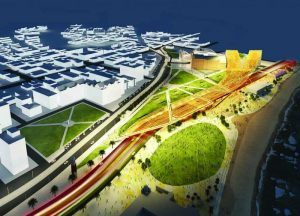Emily Matchar in Smithsonian:
 In the rendering, the structure looks like an enormous golden wave, spilling from the Upper Esplanade of Melbourne’s St Kilda Beach, crossing a busy road and crashing onto the sand. In reality, it would be a canopy of nearly 9,000 flexible photovoltaic panels designed to connect a shopping and entertainment district with the beach while generating renewable energy. Called “Light Up,” the proposal is the winner of a contest sponsored by the Land Art Generator Initiative (LAGI), an organization whose goal is to “accelerate the transition to post-carbon economies by providing models of renewable energy infrastructure that add value to public space, inspire, and educate.” They’ve been hosting biannual competitions for green energy-generating public art since 2010. Each contest has been centered on a different location—a Copenhagen shipyard, a Dubai desert road, a Santa Monica waterfront—that presents an urban design challenge. The challenge for the Melbourne competition involved creating a sense of cohesion for the “St Kilda Triangle,” an area bounded by a hilltop market area, busy Jacka Boulevard and an entertainment district containing a historic theater and the city’s iconic Luna Park amusement park, all adjacent to the popular beach. The area, which is pedestrian-unfriendly, harshly sunny and blighted with an ugly sprawling parking lot, has been a topic of redevelopment debate for years.
In the rendering, the structure looks like an enormous golden wave, spilling from the Upper Esplanade of Melbourne’s St Kilda Beach, crossing a busy road and crashing onto the sand. In reality, it would be a canopy of nearly 9,000 flexible photovoltaic panels designed to connect a shopping and entertainment district with the beach while generating renewable energy. Called “Light Up,” the proposal is the winner of a contest sponsored by the Land Art Generator Initiative (LAGI), an organization whose goal is to “accelerate the transition to post-carbon economies by providing models of renewable energy infrastructure that add value to public space, inspire, and educate.” They’ve been hosting biannual competitions for green energy-generating public art since 2010. Each contest has been centered on a different location—a Copenhagen shipyard, a Dubai desert road, a Santa Monica waterfront—that presents an urban design challenge. The challenge for the Melbourne competition involved creating a sense of cohesion for the “St Kilda Triangle,” an area bounded by a hilltop market area, busy Jacka Boulevard and an entertainment district containing a historic theater and the city’s iconic Luna Park amusement park, all adjacent to the popular beach. The area, which is pedestrian-unfriendly, harshly sunny and blighted with an ugly sprawling parking lot, has been a topic of redevelopment debate for years.
…The proposal would have the solar panel canopy cover a large stretch of street, creating shade below and a bridge to the beach above. In addition to the solar panels, the proposal includes wind power generated by the swaying bridge and microbial fuel cells. Combined, it could produce enough energy to power 500 Australian homes in addition to the site’s theater and amusement park. Lithium-ion cells from used electric car batteries embedded in the handrails of the bridge can store excess energy generated by the panels. This extra energy can then be fed back into the grid. The plan includes designs for a hotel and cultural center as well, with the intention of making the area a new urban landmark.
More here.
